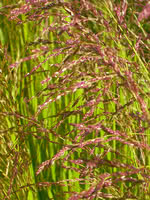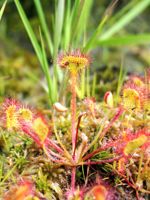Mon-Fri 9am - 5pm Mountain time
Tall Manna Grass vs Round-Leaved Sundew
Glyceria grandis
Drosera rotundifolia
CUSTOM GROW
CUSTOM GROW
Manna Grass and other waterside plants are an excellent way to prevent erosion and provide habitat and forage for animals. The difference is that Manna Grass looks better doing it! With distinctive purple grains at the top of its stalks, Manna Grass adds a splash of color to the waterside that most other aquatics can't offer.
Manna Grass is good for returning disturbed sites to nature and provides nourishment to many animals, except for cattle who find it toxic.
Round-Leaved Sundew is a native carnivorous plant, easily recognized by its bright green leaves covered in distinctive red, glandular hairs. These hairs secrete a sticky substance that is used to attract, trap, and digest insects. Their carnivorous nature allows them to survive in nutrient-poor, acidic soils where many other plants may struggle to grow.
They produce small white flowers that grow along the top of a slender, leafless stem. They can be found growing in wetlands, most often among sphagnum moss, in consistently moist, acidic soils. It does best in cooler summer climates and is intolerant of shade. Due to its small size, the plant can be difficult to spot in its natural habitat. Round-Leaved Sundew is an indicator of healthy wetland systems and is valued in ecological restoration and conservation projects.
Tall Manna Grass Quick Facts
Round-Leaved Sundew Quick Facts
Toxicity: toxic to cattle

